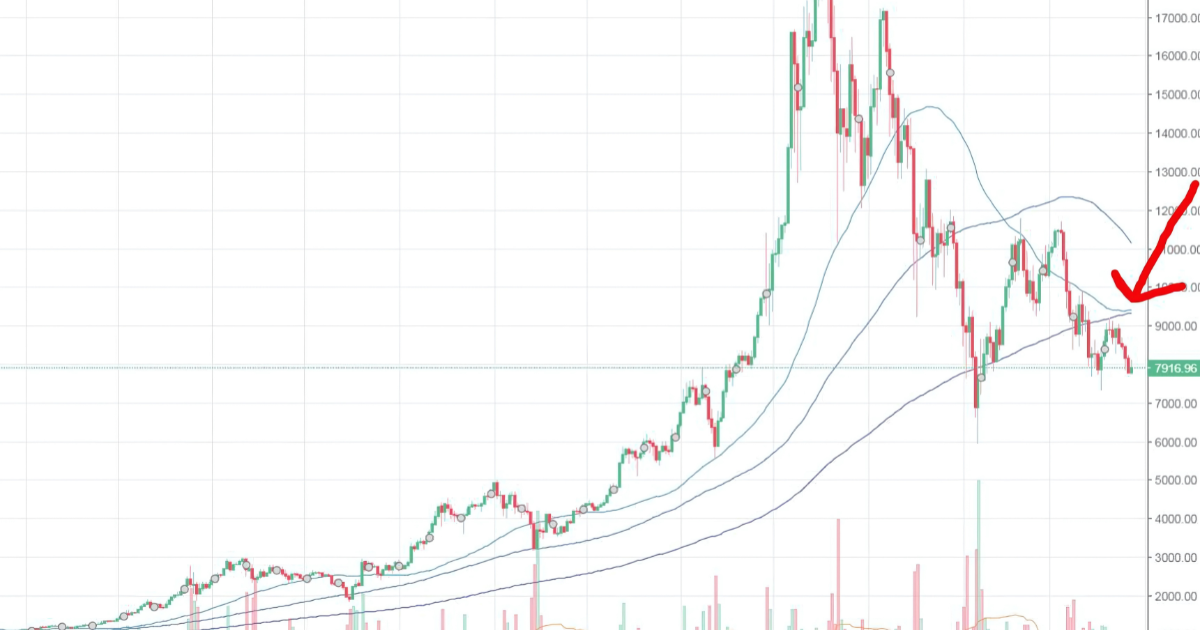Traders use several technical indicators in the cryptocurrency market to make investment decisions. There are many of these indicators, but one of them takes the limelight in terms of discussion among the investors, and that is the Bitcoin death cross. When Bitcoin’s short-term moving average crosses below its long-term moving average, this forms the technical chart pattern known as the death cross. This pattern can help investors navigate the volatile cryptocurrency market more easily and effectively.
Key-Takeaways:
- One of the Bitcoin Death Crosses takes place when the 50-day moving average falls under the 200-day moving average, indicating abating price momentum.
- While the Bitcoin Death Cross has an ominous name, it actually tends to predict above-average returns coming more often than another decline.
- The Bitcoin Death Cross, though, is just one of many tools that investors should use and not to make any decisions based off of it alone.
- The Death Cross is the bearish version of the golden cross, where long-term averages fall below short-term averages of the given pair of averages, hinting at bearish momentum.
Understanding the Bitcoin Death Cross
 A death cross forms when Bitcoin’s temporary moving average, typically the 50-day moving average, falls below its long-term moving average, usually the 200-day moving average. It shows that recent price action has been weaker than how things were moving in the long run. This indicator is watched carefully because a shift in market momentum can be indicated. The shorter line tends to cross below the longer line, thus forming the pattern’s ‘cross’; hence the tag.
A death cross forms when Bitcoin’s temporary moving average, typically the 50-day moving average, falls below its long-term moving average, usually the 200-day moving average. It shows that recent price action has been weaker than how things were moving in the long run. This indicator is watched carefully because a shift in market momentum can be indicated. The shorter line tends to cross below the longer line, thus forming the pattern’s ‘cross’; hence the tag.
The Bitcoin death cross isn’t necessarily a disaster, but its ominous name might have already transmuted it into something morbid. This pattern appears, and results are mixed historically. By simply being a pattern, it merely suggests that the integral performance of Bitcoin’s price has slowed down for nearly the last two months. The deterioration may be reversed or can continue, relying on the market conditions and other factors pertaining to cryptocurrency prices.
Historical Performance After Bitcoin Death Crosses
 Throughout its history, Bitcoin has had several death cross events, with obviously not all of them resulting in death. First of all, there have been some death crosses that have preceded a significant downturn in Bitcoin’s price. But there have been plenty of instances where there were big rebounds, rather than continuing losses.
Throughout its history, Bitcoin has had several death cross events, with obviously not all of them resulting in death. First of all, there have been some death crosses that have preceded a significant downturn in Bitcoin’s price. But there have been plenty of instances where there were big rebounds, rather than continuing losses.
The death cross is a coincident leading indicator, not a leading one; it illustrates its inconsistent predictive value. The confirmation of recent weakness does not reliably serve to forecast future performance in the cryptocurrency market.
The fact that Bitcoin tends to hand off above-average returns in the months following a death cross is confirmed through market analysis. The death cross performance, however, contradicts the idea that the death cross is always a bearish signal. According to some analysts, once a death cross is formed, much of the selling pressure would already have exhausted itself. And this exhaustion — although it’s making the price decline — may instead help create conditions for a price recovery instead of a continuation of the decline.
Bitcoin’s Bullish Counterpart
 The golden cross is the opposite of the death cross, which takes place when Bitcoin’s short-term moving average rises over its long-term moving average. Among many crypto traders, this is usually a bullish signal. In a golden cross, it means that the downward momentum was finished, and it might give the opportunity for the price to begin to rise. Both these crossing patterns act as the complement of signals from technical analysis, helping in pinpointing the potential trend changes in Bitcoin’s price action.
The golden cross is the opposite of the death cross, which takes place when Bitcoin’s short-term moving average rises over its long-term moving average. Among many crypto traders, this is usually a bullish signal. In a golden cross, it means that the downward momentum was finished, and it might give the opportunity for the price to begin to rise. Both these crossing patterns act as the complement of signals from technical analysis, helping in pinpointing the potential trend changes in Bitcoin’s price action.
One has very few, if any, limits when relying solely on the death cross for Bitcoin trading decisions. Such a simple indicator would soon lose its effectiveness if it did predict market movements as surely as in this example, because traders would soon exploit the pattern. A short market history and relative volatility combined with the cryptocurrency market touch it: do not regard the traditional technical indicators as much as some of the other markets. The death cross is often in headlines, but it relies more on the confirmation of recent weakness than on forecasting future behavior.
Conclusion: Bitcoin Death Cross
The death cross is simply one tool used by smart Bitcoin investors in their arsenal of analysis. This indicator is a complementary indicator, used in conjunction with other signals, fundamental analysis, and market sentiment.
It is the knowledge of what the Bitcoin death cross implies and its limitations that aids investors in making more informed decisions. With this knowledge, panic selling of stocks based solely on a technical pattern of a mixed historical track record is eliminated.











